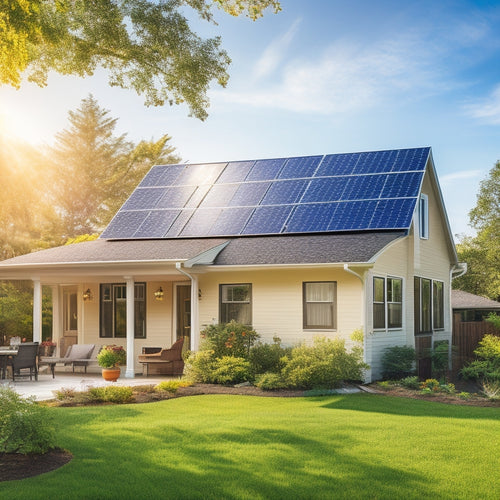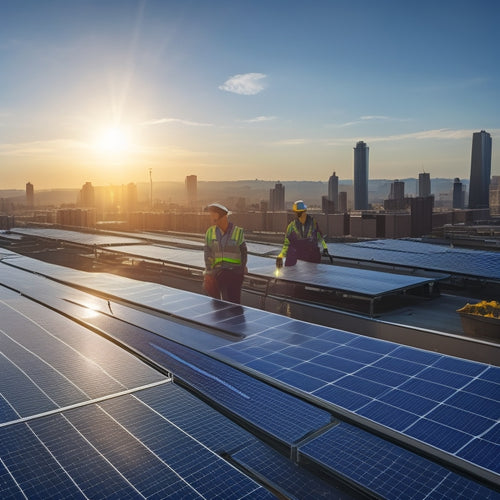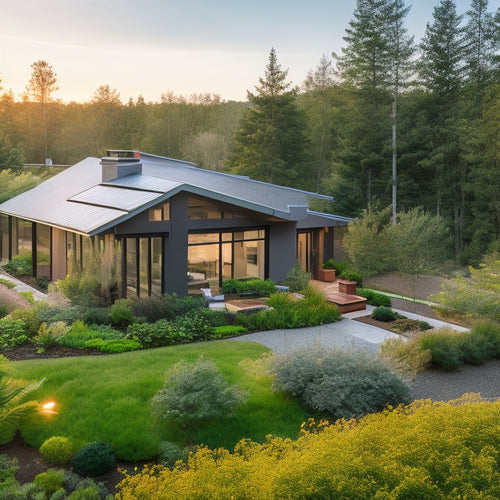
What to Consider When Buying Solar Panels and Systems
Share
When buying solar panels and systems, you'll want to take into account your energy needs assessment to identify consumption patterns and peak usage hours. Choose the right solar panel based on efficiency, environmental impact, and warranty terms. Determine the best system size and configuration, including array orientation and inverter type, to meet your energy goals. Factor in installation and maintenance costs, as well as local incentives and policies that can impact your investment. Finally, evaluate warranty and support options to guarantee your system performs as expected. As you weigh these factors, you'll be well on your way to making an informed decision that powers your home efficiently and sustainably.
Key Takeaways
- Analyze past energy bills to identify consumption patterns and optimize solar energy goals based on high-energy usage areas.
- Select high-efficiency solar panels (above 20%) from Tier 1 manufacturers with eco-friendly production methods and durable warranties.
- Calculate the required system size and configuration based on energy needs, considering array orientation, inverter type, and shading analysis.
- Evaluate installation conditions, including roof type and orientation, and factor in maintenance requirements, aesthetic options, and local incentives.
- Consider warranty and support options, including product, performance, and installation guarantees, as well as customer service and maintenance plans.
Understanding Your Energy Needs
When sizing up your energy needs, consider your current electricity usage as a critical factor in determining the number of solar panels required to meet your energy demands.
Analyze your past energy bills to identify your energy consumption patterns, including peak usage hours and seasons. This data will help you pinpoint areas of high energy consumption and optimize your solar energy goals.
Assess your energy usage by calculating your total daily energy consumption in watt-hours (Wh). This will give you a clear depiction of your energy needs and help you determine the required solar panel capacity.
Consider factors such as the size and type of appliances, lighting, and electronics in your home or business. Additionally, consider any energy-intensive systems, like HVAC or water pumps, that may impact your energy consumption.
Choosing the Right Solar Panel
Now that you've determined your energy needs, you're ready to select the right solar panel for your specific requirements. When choosing a solar panel, consider the type of solar technology that best fits your needs. Monocrystalline silicon panels offer high efficiency, while polycrystalline silicon panels provide a more affordable option. Thin-film panels, on the other hand, are a good choice for those with limited roof space.
Stay up-to-date with the latest solar technology trends, as advancements in panel design and materials continue to improve efficiency and reduce costs. Additionally, consider the environmental impact of your solar panel choice. Look for panels with eco-friendly production methods and recyclable materials.
Assess the panel's durability and warranty offered by the manufacturer. A high-quality panel with a lengthy warranty can provide peace of mind and protect your investment.
System Size and Configuration
When determining the ideal system size and configuration for your solar panel installation, you'll need to calculate the number of panels required to meet your energy needs.
You'll also need to evaluate the array orientation options, including roof-mounted, ground-mounted, and tracking systems, to guarantee maximum energy production.
Additionally, you'll have to decide on the inverter configuration type, such as string, micro, or power optimizer, to efficiently convert DC power to AC power for your home or business.
Panel Quantity Needed
To determine the panel quantity needed for your solar panel system, you'll need to evaluate the size and configuration of your system. This involves considering your energy consumption, panel placement, and the amount of energy you want to generate.
| Energy Consumption (kWh) | System Size (kW) | Number of Panels |
|---|---|---|
| 500-700 | 2-3 kW | 8-12 |
| 700-1000 | 3-5 kW | 12-20 |
| 1000-1500 | 5-7 kW | 20-28 |
| 1500-2000 | 7-10 kW | 28-40 |
The table above provides a general guideline for determining the number of panels needed based on your energy consumption and system size. Keep in mind that this is just an estimate, and the actual number of panels required may vary depending on several factors, including the quality and efficiency of the panels, local building codes, and the amount of shading in your area. By carefully evaluating these factors, you can determine the ideal panel quantity needed for your solar panel system.
Array Orientation Options
Your solar panel array's orientation greatly impacts its energy production, and careful planning is vital to maximize its performance. When deciding on an array orientation, consider the installation angle, which affects energy output. A tilt between 30-40 degrees is often ideal, but this may vary depending on your geographic location and roof material.
Conduct a shading analysis to identify potential obstacles and optimize panel alignment. Aesthetic preferences may also influence your decision, as some homeowners prefer a more discreet installation.
Solar tracking systems can enhance energy production by adjusting the array's angle throughout the day. However, these systems may not be compatible with all roof types or regulatory requirements. Verify system compatibility and comply with local regulations when selecting an array orientation.
Additionally, consider your roof's material and structural integrity to support the array's weight and installation requirements. By carefully evaluating these factors, you can optimize your solar panel array's performance and energy production.
Inverter Configuration Types
Frequently, homeowners overlook the significance of inverter configuration when designing their solar panel system, leading to reduced energy production and efficiency.
When selecting an inverter, you'll encounter four primary configuration types: string inverters, micro inverters, power optimizers, and hybrid inverters.
String inverters are the most common, connecting multiple panels in a series, but they can be affected by shading or panel mismatch.
Micro inverters, on the other hand, are installed under each panel, providing maximum power point tracking and better performance in shaded conditions.
Power optimizers offer a compromise between the two, optimizing energy output at the panel level.
Hybrid inverters combine solar and storage capabilities, ideal for grid-tied systems with battery integration.
It's crucial to reflect on inverter efficiency, compatibility, and monitoring capabilities when choosing the right configuration for your system.
For off-grid solutions, you may require a specialized inverter designed for standalone systems.
Panel Efficiency and Quality
When evaluating solar panels, you'll want to take into account their efficiency and quality to guarantee you're getting the best performance for your investment.
High-efficiency ratings, typically above 20%, can greatly impact your system's overall energy production.
Additionally, you'll want to look for panels from Tier 1 manufacturers that offer durability and longevity, often backed by 25-year warranties.
High Efficiency Ratings
Efficiency is the cornerstone of a successful solar panel system, as it directly impacts the amount of electricity generated per unit area.
When evaluating high-efficiency solar panels, you'll want to take into account the following factors that influence performance benchmarks:
-
Conversion efficiency: The percentage of sunlight converted into electricity. Higher efficiency ratings mean more power per unit area.
-
Temperature coefficient: The rate at which efficiency decreases as temperature increases. Look for panels with low temperature coefficients to minimize energy losses.
-
Fill factor: A measure of how efficiently the panel converts sunlight into electrical current. Higher fill factors indicate better performance.
- Maximum power point tracking: The ability of the inverter to maximize energy yield by identifying the ideal operating voltage and current.
When choosing high-efficiency solar panels, prioritize those with high conversion efficiency, low temperature coefficients, and high fill factors.
This will guarantee you get the most energy yield from your solar panel system, maximizing your return on investment.
Durability and Longevity
Reliability is the backbone of a successful solar panel system, as it directly impacts the long-term return on investment. When evaluating durability and longevity, you should take into account the weather resistance of the panels, as well as the material quality and testing standards used in their construction.
A high-quality solar panel system should be able to withstand various environmental conditions, including extreme temperatures, humidity, and weather events.
You'll also want to take into account the installation conditions, maintenance requirements, and potential for performance degradation over time. Look for panels with a proven track record of performance and a manufacturer warranty that covers repairs and replacements.
Additionally, think about the aesthetic options available, as well as the market trends and technological advancements that may impact the system's longevity. By taking these factors into account, you can guarantee that your solar panel system provides a strong return on investment and minimizes its environmental impact.
Tier 1 Manufacturers
As you evaluate the durability and longevity of a solar panel system, you'll want to take into account the quality of the panels themselves, which is where Tier 1 manufacturers come in.
These top-tier manufacturers are recognized for their high-quality products, sturdy manufacturing processes, and strong brand reputation.
When choosing a Tier 1 manufacturer, you can expect:
-
Higher efficiency rates: Tier 1 manufacturers typically offer higher efficiency rates, resulting in more power output per unit area.
-
Better durability: Their products are built to last, with a longer lifespan and lower degradation rates.
-
Stronger warranties: Tier 1 manufacturers usually offer more extensive warranties, providing you with greater peace of mind.
- Positive customer reviews: They've a proven track record of customer satisfaction, with overwhelmingly positive reviews and ratings.
Installation and Maintenance Costs
With the cost of solar panels themselves factored into your overall budget, it's essential to evaluate the additional expenses associated with installation and maintenance.
These costs can vary widely depending on the complexity of the installation, local labor rates, and the quality of the installation company. You'll want to take into account the installation techniques used, such as roof-mounted or ground-mounted systems, and whether they require additional hardware or labor.
When it comes to maintenance, you'll need to factor in regular cleaning and inspections to guarantee peak performance. A well-planned maintenance schedule can help prevent issues and minimize downtime.
You may also need to take into account the cost of replacing inverters or other components over the system's lifespan. Be sure to ask potential installers about their maintenance schedules and costs, as well as any warranties or guarantees they offer.
Local Incentives and Policies
You've accounted for the costs of solar panels and installation, as well as ongoing maintenance.
Now, it's crucial to investigate the local incentives and policies that can greatly influence the overall affordability and benefits of your solar panel system.
Researching these incentives can help you maximize your savings and returns on investment.
Here are some key policies and incentives to evaluate:
-
Federal Incentives: Federal tax credits can cover up to 26% of your total system cost. Make sure to factor this into your overall budget.
-
State Policies: Net metering laws, community solar programs, and renewable energy credits can vary by state. Understand how these policies affect your system's performance and value.
-
Local Rebates: Many cities and counties offer rebates or property tax exemptions for solar installations. Look into these local incentives to further reduce your upfront costs.
- Zoning Regulations: Familiarize yourself with local zoning laws and regulations that may impact your system's design, installation, or operation.
Warranty and Support Options
When considering solar panels, warranty and support options are essential aspects to evaluate, as they directly impact the long-term reliability and performance of your system. You'll want to research the different warranty types offered, such as product warranties, performance warranties, and installation guarantees.
| Warranty Type | Coverage | Duration |
|---|---|---|
| Product Warranty | Defects in materials and workmanship | 10-25 years |
| Performance Warranty | Energy production guarantees | 25 years or more |
| Installation Guarantee | Workmanship and installation quality | 1-10 years |
In addition to warranty types, consider the support services offered by the manufacturer and installer. Look for 24/7 customer support, online resources, and maintenance plans. Read customer reviews to get a sense of the company's claims process and response times. A thorough warranty and support package can provide peace of mind and protect your investment in the long run. Be sure to carefully evaluate these options when selecting a solar panel system.
Frequently Asked Questions
Can I Install Solar Panels on My Own or Diy?
You can attempt a DIY solar panel installation, but you'll still need to obtain installation permits and guarantee compliance with safety regulations, which can be complex and time-consuming, so it's often recommended to hire a professional.
Will Solar Panels Work During Power Outages?
When the grid goes down, you'll be glad you invested in a solar panel system with battery storage, as it'll keep your lights on, but note that solar panel efficiency may vary depending on the type and quality of your system.
Are Solar Panels Affected by Shade or Trees?
You'll want to assess how shade from trees or other obstructions impacts your solar panel's energy output, as even partial shade can greatly reduce production; consider tree management strategies to minimize shade impact and optimize energy harvesting.
Can I Upgrade My Solar Panel System Later?
As you scale the peak of renewable energy, you're wondering if you can upgrade your solar panel system later. Fortunately, yes, you can, as long as you guarantee system compatibility and plan for future expansion, avoiding a patchwork of mismatched components.
Do Solar Panels Require Regular Cleaning?
You'll need to regularly clean your solar panels to maintain peak energy production, as dirt and debris can reduce solar panel efficiency by up to 25%. Learn effective cleaning techniques, such as soft-brush washing and deionized water, to maximize your energy output.
Conclusion
Now that you've considered all the key factors, you're ready to make an informed decision about your solar panel system. Will you be utilizing the power of the sun to fuel your home or business in the most efficient and cost-effective way possible? By evaluating your energy needs, panel quality, system size, and local incentives, you'll be well on your way to a sustainable energy future.
Related Posts
-

How to Finance Home Solar Panels
Financing home solar panels offers several strategies to lighten your initial costs while maximizing long-term benefi...
-

Solar Installation Guide for Commercial Properties
Implementing solar energy solutions in your commercial property can lead to significant long-term savings and sustain...
-

Sustainable Home Design for Reduced Carbon Footprint
Sustainable home design is your pathway to a smaller carbon footprint and a healthier living space. By incorporating ...


